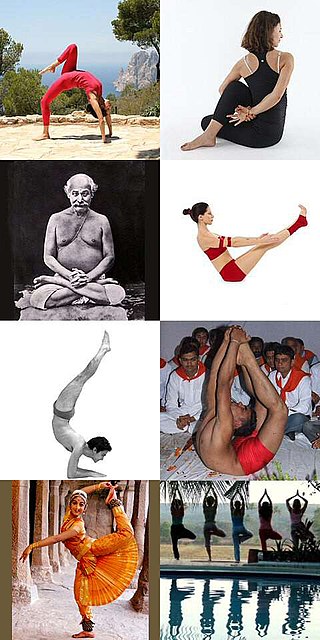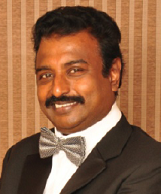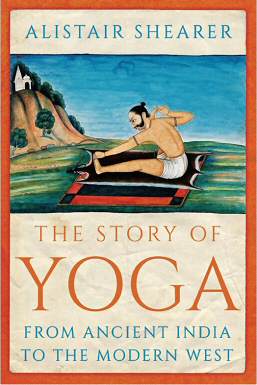Related Research Articles

Lotus position or Padmasana is a cross-legged sitting meditation pose from ancient India, in which each foot is placed on the opposite thigh. It is an ancient asana in yoga, predating hatha yoga, and is widely used for meditation in Hindu, Tantra, Jain, and Buddhist traditions.

K. Pattabhi Jois was an Indian yoga guru who developed and popularized the flowing style of yoga as exercise known as Ashtanga vinyasa yoga. In 1948, Jois established the Ashtanga Yoga Research Institute in Mysore, India. Pattabhi Jois is one of a short list of Indians instrumental in establishing modern yoga as exercise in the 20th century, along with B. K. S. Iyengar, another pupil of Krishnamacharya in Mysore. Jois sexually abused some of his yoga students by touching inappropriately during adjustments. Sharath Jois has publicly apologised for his grandfather's "improper adjustments".

Bellur Krishnamachar Sundararaja Iyengar was an Indian teacher of yoga and author. He is founder of the style of yoga as exercise, known as "Iyengar Yoga", and was considered one of the foremost yoga gurus in the world. He was the author of many books on yoga practice and philosophy including Light on Yoga, Light on Pranayama, Light on the Yoga Sutras of Patanjali, and Light on Life. Iyengar was one of the earliest students of Tirumalai Krishnamacharya, who is often referred to as "the father of modern yoga". He has been credited with popularizing yoga, first in India and then around the world.

An āsana is a body posture, originally and still a general term for a sitting meditation pose, and later extended in hatha yoga and modern yoga as exercise, to any type of position, adding reclining, standing, inverted, twisting, and balancing poses. The Yoga Sutras of Patanjali define "asana" as "[a position that] is steady and comfortable". Patanjali mentions the ability to sit for extended periods as one of the eight limbs of his system. Asanas are also called yoga poses or yoga postures in English.

Arundhati Nag is an Indian actress. She has been involved with multilingual Theatre in India, for over 25 years, first in Mumbai where she got involved with Indian People's Theatre Association (IPTA), and did various productions in Gujarati, Marathi, and Hindi theatre, and then in Kannada, Tamil, Malayalam and English, in Bangalore.
Keshava Parasaran is a lawyer from India. He was Advocate General of Tamil Nadu during President's rule in 1976, Solicitor General of India under the then Prime Minister Indira Gandhi and then, Attorney General of India under Prime Ministers Indira Gandhi and Rajiv Gandhi between 1983 and 1989, till the end of Rajiv Gandhi's tenure. Parasaran was awarded the Padma Bhushan in the year 2003 and Padma Vibhushan in the year 2011. In June 2012, he received a presidential nomination to the Rajya Sabha, the upper house of India's parliament, for a period of six years. He is a member of Shri Ram Janmabhoomi Teerth Kshetra. In 2019 the Central Government appointed him to lead the Shri Ram Janmabhoomi Teerth Kshetra. However later, Mahant Nritya Gopal Das was appointed to lead the trust. The trust will oversee the construction of Ram Temple in Ayodhya.

Tao Porchon-Lynch was an American yoga master and award-winning author of French and Indian descent. She discovered yoga in 1926 when she was eight years old in India and studied with, among others, Sri Aurobindo, B.K.S. Iyengar, K. Pattabhi Jois, Swami Prabhavananda, and Maharishi Mahesh Yogi. At age 101, she taught a weekly class in New York, and led programs across the globe. She was the author of two books, including her autobiography, Dancing Light: The Spiritual Side of Being Through the Eyes of a Modern Yoga Master, which won a 2016 IPPY Award and three 2016 International Book Awards. In the front matter endorsement, Deepak Chopra said: "One of the most acclaimed yoga teachers of our century, Tao Porchon-Lynch... is a mentor to me who embodies the spirit of yoga and is an example of Ageless Body, Timeless Mind. Like yoga, she teaches us to let go and to have exquisite awareness in every moment."
Kutikuppala Surya Rao is a physician in HIV medicine. He hails from a village named Kintali, located in the Srikakulam district of Andhra Pradesh, India.
Vanaja Iyengar was an Indian mathematician, educationist and the founder vice-chancellor of Sri Padmavati Mahila Visvavidyalayam, Tirupati, in the south Indian state of Andhra Pradesh. She was one of the founders of the Andhra Mahila Sabha School of Informatics. The Government of India awarded her the fourth highest civilian honour of Padma Shri in 1987.
Sadashiv Prahlad Nimbalkar was an Indian academic, author, Yoga guru and the founder of Yoga Vidya Niketan (YVN), a Mumbai-based Yoga institute, promoting the practice of Yoga. A former physical education instructor and a vice principal of a junior college, Nimbalkar practiced Yoga under renowned teacher, Swami Kuvalayananda, one of the pioneers of Yoga research and the founder of Kaivalyadhama Yoga Institute. Yoga Vidya Niketan, the institute Nimbalkar founded, offers various courses such as Diploma in Yogic Science, Teachers Training Courses, Diploma in Yoga Therapy and Diploma in Natural Living and Naturopathy, for students and teachers.

H. R. Nagendra is an Indian mechanical engineer, Yoga therapist, academic, writer and the founder vice chancellor of Swami Vivekananda Yoga Anusandhana Samsthana (S-VYASA), a deemed university located in Bengaluru. He is best known as the personal yoga consultant of Narendra Modi, the prime minister of India and is a recipient of Yoga Shri title from the Ministry of Health and Family Welfare. He has authored 35 books and over 100 research papers on Yoga. The Government of India awarded him the fourth highest civilian honour of the Padma Shri, in 2016, for his contributions to society.

Manibhai Haribhai Desai, known as (Shri) Yogendra was an Indian yoga guru, author, poet, researcher and was one of the important figures in the modern revival of Hatha Yoga, both in India and United States. He was the founder of The Yoga Institute, the oldest organized yoga centre in the world, established in 1918. He is often referred as the Father of Modern Yoga Renaissance. He was one of the figures responsible for reviving the practice of asanas and making yoga accessible to people other than renunciates.
Modern yoga is a wide range of yoga practices with differing purposes, encompassing in its various forms yoga philosophy derived from the Vedas, physical postures derived from Hatha yoga, devotional and tantra-based practices, and Hindu nation-building approaches.

Yoga as exercise is a physical activity consisting mainly of postures, often connected by flowing sequences, sometimes accompanied by breathing exercises, and frequently ending with relaxation lying down or meditation. Yoga in this form has become familiar across the world, especially in America and Europe. It is derived from medieval Haṭha yoga, which made use of similar postures, but it is generally simply called "yoga". Academics have given yoga as exercise a variety of names, including modern postural yoga and transnational anglophone yoga.

Sundaram Natarajan is an Indian ophthalmologist. In 2002, he started a free clinic in Dharavi, a slum in Mumbai, and treated more than 8,000 people. He has also held free camps in various other suburbs of Mumbai such as Mankhurd and Govandi to treat the economically poor. In 2016, he also held a camp in Kashmir to operate and cure the victims of pellet gun firings.

The standing asanas are the yoga poses or asanas with one or both feet on the ground, and the body more or less upright. They are among the most distinctive features of modern yoga as exercise. Until the 20th century there were very few of these, the best example being Vrikshasana, Tree Pose. From the time of Krishnamacharya in Mysore, many standing poses have been created. Two major sources of these asanas have been identified: the exercise sequence Surya Namaskar ; and the gymnastics widely practised in India at the time, based on the prevailing physical culture.

Postural yoga began in India as a variant of traditional yoga, which was a mainly meditational practice; it has spread across the world and returned to the Indian subcontinent in different forms. The ancient Yoga Sutras of Patanjali mention yoga postures, asanas, only briefly, as meditation seats. Medieval Haṭha yoga made use of a small number of asanas alongside other techniques such as pranayama, shatkarmas, and mudras, but it was despised and almost extinct by the start of the 20th century. At that time, the revival of postural yoga was at first driven by Indian nationalism. Advocates such as Yogendra and Kuvalayananda made yoga acceptable in the 1920s, treating it as a medical subject. From the 1930s, the "father of modern yoga" Krishnamacharya developed a vigorous postural yoga, influenced by gymnastics, with transitions (vinyasas) that allowed one pose to flow into the next.

The Story of Yoga: From Ancient India to the Modern West is a cultural history of yoga by Alistair Shearer, published by Hurst in 2020. It narrates how an ancient spiritual practice in India became a global method of exercise, often with no spiritual content, by way of diverse movements including Indian nationalism, the Theosophical Society, Swami Vivekananda's coming to the west, self-publicising western yogis, Indian muscle builders, Krishnamacharya's practice in Mysore, and pioneering teachers like B. K. S. Iyengar.
Sivananda, also known as Swami Sivananda, is a yoga teacher from India, who has claimed to be born on 8 August 1896 (unverified) in Sylhet District of Bengal Presidency of British India. On 21 March 2022, he was awarded Padma Shri by the Government of India.
References
- 1 2 3 "Founder Managing Trustee". Kripa Foundation. 2016. Retrieved 27 February 2016.
- 1 2 3 "Rev. Fr. Joseph H Pereira – Founder and Managing Trustee of the Kripa Foundation". NGO Gateway. 2016. Retrieved 27 February 2016.
- 1 2 "Padma Awards" (PDF). Ministry of Home Affairs, Government of India. 2016. Archived from the original (PDF) on 15 October 2015. Retrieved 3 January 2016.
- 1 2 "The Best Way of Helping Is To Care". Yoga Teacher Magazine. 2 (1). 2014.
- 1 2 "About Father Joe Pereira". Iyengar Yoga HK. 2016. Retrieved 28 February 2016.
- ↑ "About Us". Kripa Foundation. 2016. Retrieved 28 February 2016.
- ↑ "In Mumbai, a Catholic priest-yogi attacks Western propaganda against yoga". Scroll.in. 7 April 2015. Retrieved 28 February 2016.
- ↑ Joseph Pereira (2009). Yoga for the Practice of Christian Meditation. MedioMedia. ISBN 978-1933182957.